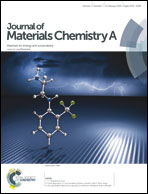Development of pervaporation membranes using chitosan and titanium glycine-N,N-dimethylphosphonate for dehydration of isopropanol†
Abstract
Titanium glycine-N,N-dimethylphosphonate, Ti[(O3PCH2)2NCH2COOH] (TGDMP), was synthesized and incorporated into chitosan in different weight ratios to obtain nanocomposite membranes. TGDMP acts as an electronegative nanofiller owing to the large number of –COOH groups and thereby establishes an electrostatic interaction between the nanofiller and chitosan. The structure, morphology, and thermal properties of the resulting membranes were studied using different techniques such as Fourier transform infrared (FTIR) spectroscopy, wide-angle X-ray diffraction (WAXD), differential scanning calorimetry (DSC), thermogravimetric analysis (TGA) and scanning electron microscopy (SEM). The membranes were subjected to pervaporation dehydration of isopropanol at different temperatures. The effect of TGDMP on the pervaporation performance was investigated systematically. The separation factor and permeation flux of the resulting nanocomposite membranes are much higher than those of the pure chitosan membrane. The membrane containing 1.2 mass% of TGDMP demonstrated the highest separation factor of 1050 with a permeation flux of 7.37 × 10−2 kg m−2 h−1 at 30 °C for 10 mass% of water in the feed. The total flux and flux of water are found to be overlapping particularly for TGDMP incorporated membranes, illustrating that the developed nanocomposite membranes could be used effectively to break the azeotropic point of water–isopropanol mixtures. From the temperature dependent diffusion and permeation values, the Arrhenius activation parameters were estimated. The activation energy values obtained for water permeation (Epw) are significantly lower than those of isopropanol permeation (EpIPA), suggesting that the developed membranes have a higher separation ability for the water–isopropanol system. The estimated Ep and ED values ranged between 20.00 and 2.52, and 19.72 and 2.48 kJ mol−1, respectively. Positive heat of sorption (ΔHs) values were obtained for all the membranes, suggesting that Henry's mode of sorption was predominant.


 Please wait while we load your content...
Please wait while we load your content...